Analyzing Forms of Communication for Business Excellence
VerifiedAdded on 2022/05/25
|5
|3126
|15
Report
AI Summary
This report examines the multifaceted nature of business communication, emphasizing its critical role in organizational success. It categorizes business communication into external and internal forms and explores various mediums, including verbal, written, and nonverbal methods. The report highlights the advantages and disadvantages of each medium, providing examples of their practical application in the workplace. Verbal communication is presented as a natural and comfortable mode, written communication as essential for clarity and documentation, and nonverbal communication for its ability to convey unspoken messages. Additionally, the report underscores the importance of face-to-face communication and offers tips on adopting a professional appearance and body language to enhance communication effectiveness. It concludes by stressing the significance of appearance and body language in conveying professionalism and emotions, essential for successful interactions within the workplace. This analysis provides practical strategies for improving business communication and fostering a more productive work environment.
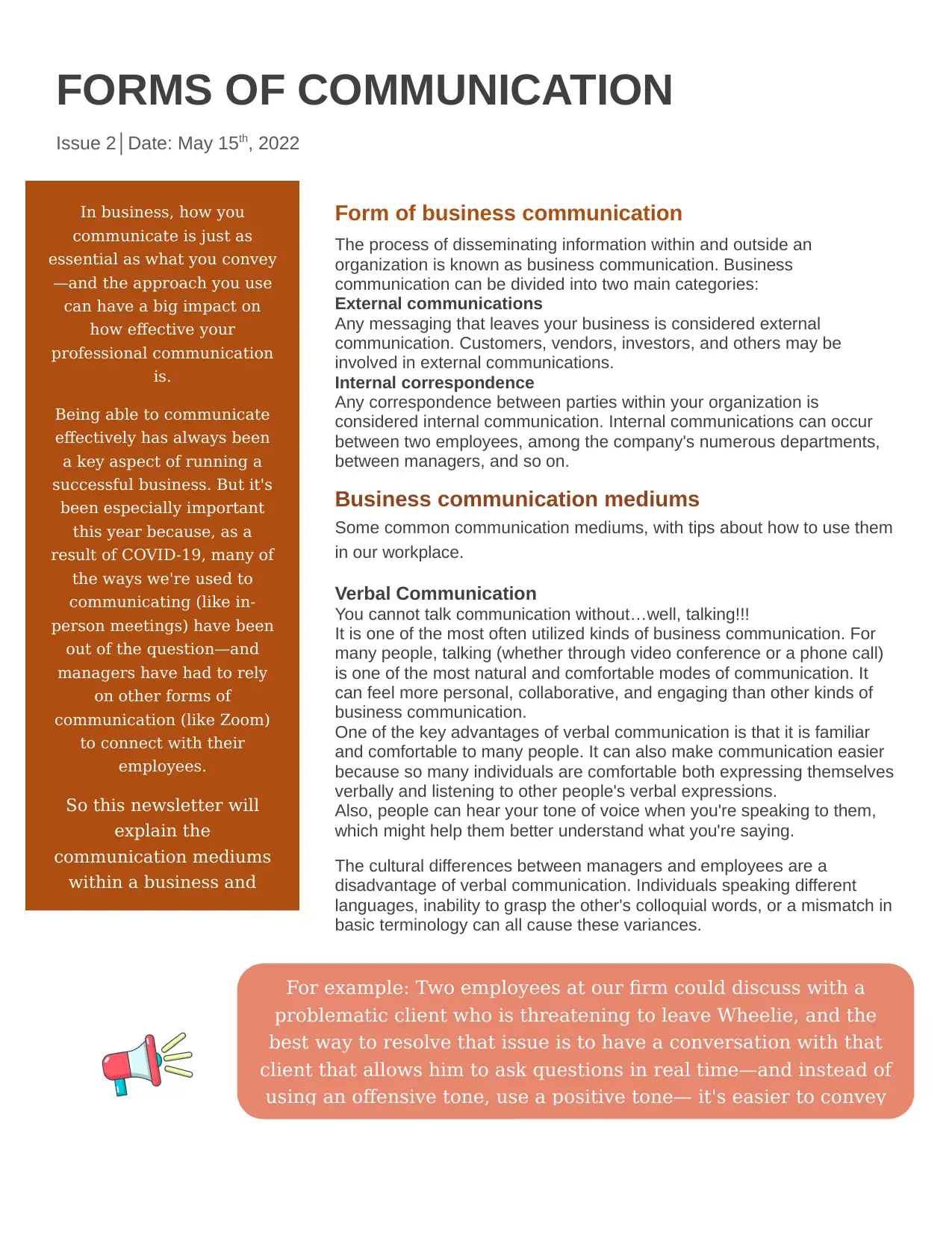
FORMS OF COMMUNICATION
Issue 2│Date: May 15th, 2022
Form of business communication
The process of disseminating information within and outside an
organization is known as business communication. Business
communication can be divided into two main categories:
External communications
Any messaging that leaves your business is considered external
communication. Customers, vendors, investors, and others may be
involved in external communications.
Internal correspondence
Any correspondence between parties within your organization is
considered internal communication. Internal communications can occur
between two employees, among the company's numerous departments,
between managers, and so on.
Business communication mediums
Some common communication mediums, with tips about how to use them
in our workplace.
Verbal Communication
You cannot talk communication without…well, talking!!!
It is one of the most often utilized kinds of business communication. For
many people, talking (whether through video conference or a phone call)
is one of the most natural and comfortable modes of communication. It
can feel more personal, collaborative, and engaging than other kinds of
business communication.
One of the key advantages of verbal communication is that it is familiar
and comfortable to many people. It can also make communication easier
because so many individuals are comfortable both expressing themselves
verbally and listening to other people's verbal expressions.
Also, people can hear your tone of voice when you're speaking to them,
which might help them better understand what you're saying.
The cultural differences between managers and employees are a
disadvantage of verbal communication. Individuals speaking different
languages, inability to grasp the other's colloquial words, or a mismatch in
basic terminology can all cause these variances.
In business, how you
communicate is just as
essential as what you convey
—and the approach you use
can have a big impact on
how effective your
professional communication
is.
Being able to communicate
effectively has always been
a key aspect of running a
successful business. But it's
been especially important
this year because, as a
result of COVID-19, many of
the ways we're used to
communicating (like in-
person meetings) have been
out of the question—and
managers have had to rely
on other forms of
communication (like Zoom)
to connect with their
employees.
So this newsletter will
explain the
communication mediums
within a business and
For example: Two employees at our firm could discuss with a
problematic client who is threatening to leave Wheelie, and the
best way to resolve that issue is to have a conversation with that
client that allows him to ask questions in real time—and instead of
using an offensive tone, use a positive tone— it's easier to convey
Issue 2│Date: May 15th, 2022
Form of business communication
The process of disseminating information within and outside an
organization is known as business communication. Business
communication can be divided into two main categories:
External communications
Any messaging that leaves your business is considered external
communication. Customers, vendors, investors, and others may be
involved in external communications.
Internal correspondence
Any correspondence between parties within your organization is
considered internal communication. Internal communications can occur
between two employees, among the company's numerous departments,
between managers, and so on.
Business communication mediums
Some common communication mediums, with tips about how to use them
in our workplace.
Verbal Communication
You cannot talk communication without…well, talking!!!
It is one of the most often utilized kinds of business communication. For
many people, talking (whether through video conference or a phone call)
is one of the most natural and comfortable modes of communication. It
can feel more personal, collaborative, and engaging than other kinds of
business communication.
One of the key advantages of verbal communication is that it is familiar
and comfortable to many people. It can also make communication easier
because so many individuals are comfortable both expressing themselves
verbally and listening to other people's verbal expressions.
Also, people can hear your tone of voice when you're speaking to them,
which might help them better understand what you're saying.
The cultural differences between managers and employees are a
disadvantage of verbal communication. Individuals speaking different
languages, inability to grasp the other's colloquial words, or a mismatch in
basic terminology can all cause these variances.
In business, how you
communicate is just as
essential as what you convey
—and the approach you use
can have a big impact on
how effective your
professional communication
is.
Being able to communicate
effectively has always been
a key aspect of running a
successful business. But it's
been especially important
this year because, as a
result of COVID-19, many of
the ways we're used to
communicating (like in-
person meetings) have been
out of the question—and
managers have had to rely
on other forms of
communication (like Zoom)
to connect with their
employees.
So this newsletter will
explain the
communication mediums
within a business and
For example: Two employees at our firm could discuss with a
problematic client who is threatening to leave Wheelie, and the
best way to resolve that issue is to have a conversation with that
client that allows him to ask questions in real time—and instead of
using an offensive tone, use a positive tone— it's easier to convey
Paraphrase This Document
Need a fresh take? Get an instant paraphrase of this document with our AI Paraphraser
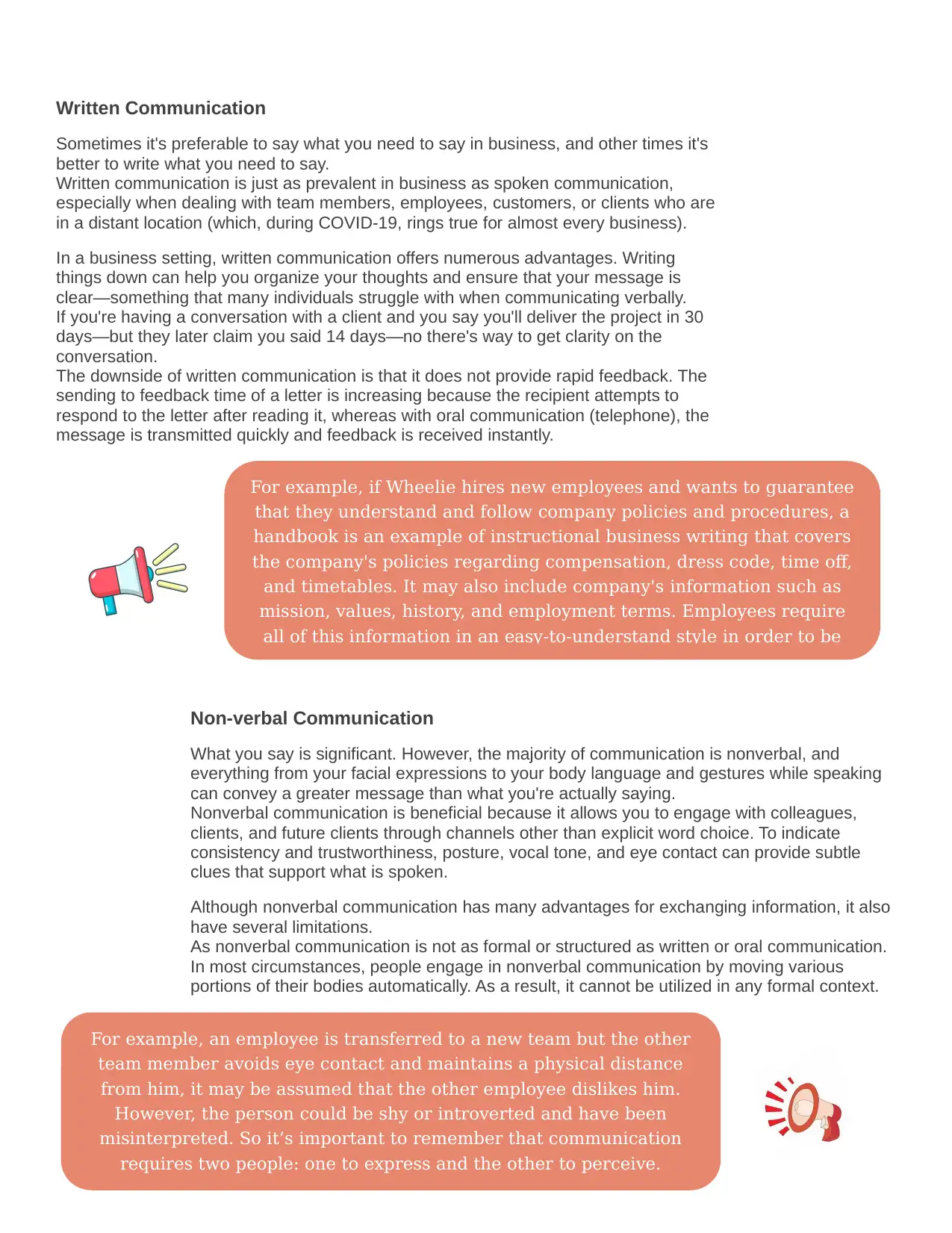
Written Communication
Sometimes it's preferable to say what you need to say in business, and other times it's
better to write what you need to say.
Written communication is just as prevalent in business as spoken communication,
especially when dealing with team members, employees, customers, or clients who are
in a distant location (which, during COVID-19, rings true for almost every business).
In a business setting, written communication offers numerous advantages. Writing
things down can help you organize your thoughts and ensure that your message is
clear—something that many individuals struggle with when communicating verbally.
If you're having a conversation with a client and you say you'll deliver the project in 30
days—but they later claim you said 14 days—no there's way to get clarity on the
conversation.
The downside of written communication is that it does not provide rapid feedback. The
sending to feedback time of a letter is increasing because the recipient attempts to
respond to the letter after reading it, whereas with oral communication (telephone), the
message is transmitted quickly and feedback is received instantly.
Non-verbal Communication
What you say is significant. However, the majority of communication is nonverbal, and
everything from your facial expressions to your body language and gestures while speaking
can convey a greater message than what you're actually saying.
Nonverbal communication is beneficial because it allows you to engage with colleagues,
clients, and future clients through channels other than explicit word choice. To indicate
consistency and trustworthiness, posture, vocal tone, and eye contact can provide subtle
clues that support what is spoken.
Although nonverbal communication has many advantages for exchanging information, it also
have several limitations.
As nonverbal communication is not as formal or structured as written or oral communication.
In most circumstances, people engage in nonverbal communication by moving various
portions of their bodies automatically. As a result, it cannot be utilized in any formal context.
For example, if Wheelie hires new employees and wants to guarantee
that they understand and follow company policies and procedures, a
handbook is an example of instructional business writing that covers
the company's policies regarding compensation, dress code, time off,
and timetables. It may also include company's information such as
mission, values, history, and employment terms. Employees require
all of this information in an easy-to-understand style in order to be
For example, an employee is transferred to a new team but the other
team member avoids eye contact and maintains a physical distance
from him, it may be assumed that the other employee dislikes him.
However, the person could be shy or introverted and have been
misinterpreted. So it’s important to remember that communication
requires two people: one to express and the other to perceive.
Sometimes it's preferable to say what you need to say in business, and other times it's
better to write what you need to say.
Written communication is just as prevalent in business as spoken communication,
especially when dealing with team members, employees, customers, or clients who are
in a distant location (which, during COVID-19, rings true for almost every business).
In a business setting, written communication offers numerous advantages. Writing
things down can help you organize your thoughts and ensure that your message is
clear—something that many individuals struggle with when communicating verbally.
If you're having a conversation with a client and you say you'll deliver the project in 30
days—but they later claim you said 14 days—no there's way to get clarity on the
conversation.
The downside of written communication is that it does not provide rapid feedback. The
sending to feedback time of a letter is increasing because the recipient attempts to
respond to the letter after reading it, whereas with oral communication (telephone), the
message is transmitted quickly and feedback is received instantly.
Non-verbal Communication
What you say is significant. However, the majority of communication is nonverbal, and
everything from your facial expressions to your body language and gestures while speaking
can convey a greater message than what you're actually saying.
Nonverbal communication is beneficial because it allows you to engage with colleagues,
clients, and future clients through channels other than explicit word choice. To indicate
consistency and trustworthiness, posture, vocal tone, and eye contact can provide subtle
clues that support what is spoken.
Although nonverbal communication has many advantages for exchanging information, it also
have several limitations.
As nonverbal communication is not as formal or structured as written or oral communication.
In most circumstances, people engage in nonverbal communication by moving various
portions of their bodies automatically. As a result, it cannot be utilized in any formal context.
For example, if Wheelie hires new employees and wants to guarantee
that they understand and follow company policies and procedures, a
handbook is an example of instructional business writing that covers
the company's policies regarding compensation, dress code, time off,
and timetables. It may also include company's information such as
mission, values, history, and employment terms. Employees require
all of this information in an easy-to-understand style in order to be
For example, an employee is transferred to a new team but the other
team member avoids eye contact and maintains a physical distance
from him, it may be assumed that the other employee dislikes him.
However, the person could be shy or introverted and have been
misinterpreted. So it’s important to remember that communication
requires two people: one to express and the other to perceive.
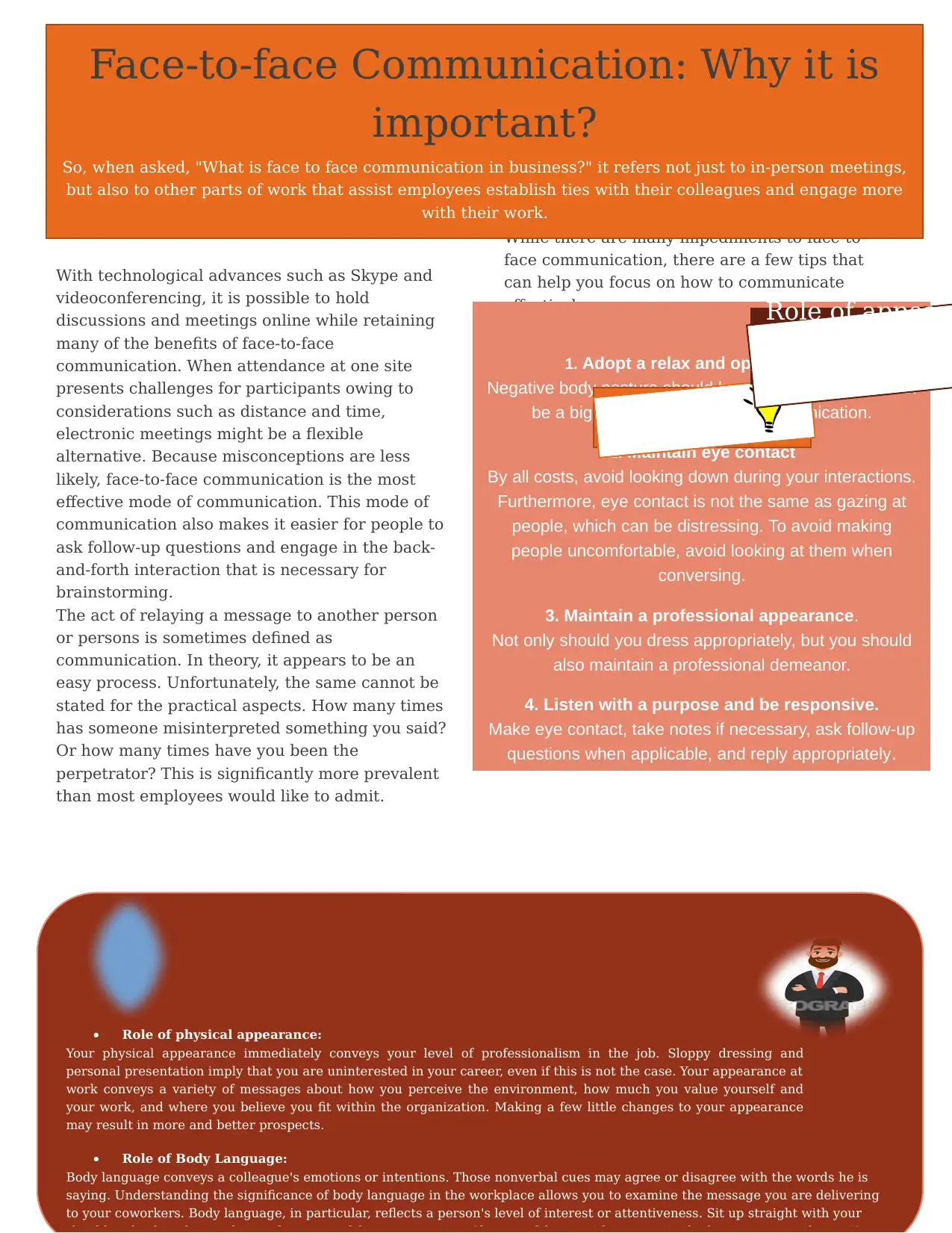
With technological advances such as Skype and
videoconferencing, it is possible to hold
discussions and meetings online while retaining
many of the benefits of face-to-face
communication. When attendance at one site
presents challenges for participants owing to
considerations such as distance and time,
electronic meetings might be a flexible
alternative. Because misconceptions are less
likely, face-to-face communication is the most
effective mode of communication. This mode of
communication also makes it easier for people to
ask follow-up questions and engage in the back-
and-forth interaction that is necessary for
brainstorming.
The act of relaying a message to another person
or persons is sometimes defined as
communication. In theory, it appears to be an
easy process. Unfortunately, the same cannot be
stated for the practical aspects. How many times
has someone misinterpreted something you said?
Or how many times have you been the
perpetrator? This is significantly more prevalent
than most employees would like to admit.
While there are many impediments to face-to-
face communication, there are a few tips that
can help you focus on how to communicate
effectively:
Face-to-face Communication: Why it is
important?
So, when asked, "What is face to face communication in business?" it refers not just to in-person meetings,
but also to other parts of work that assist employees establish ties with their colleagues and engage more
with their work.
1. Adopt a relax and open posture
Negative body posture should be avoided because it can
be a big impediment to good communication.
2. Maintain eye contact
By all costs, avoid looking down during your interactions.
Furthermore, eye contact is not the same as gazing at
people, which can be distressing. To avoid making
people uncomfortable, avoid looking at them when
conversing.
3. Maintain a professional appearance.
Not only should you dress appropriately, but you should
also maintain a professional demeanor.
4. Listen with a purpose and be responsive.
Make eye contact, take notes if necessary, ask follow-up
questions when applicable, and reply appropriately.
Tips
Role of physical appearance:
Your physical appearance immediately conveys your level of professionalism in the job. Sloppy dressing and
personal presentation imply that you are uninterested in your career, even if this is not the case. Your appearance at
work conveys a variety of messages about how you perceive the environment, how much you value yourself and
your work, and where you believe you fit within the organization. Making a few little changes to your appearance
may result in more and better prospects.
Role of Body Language:
Body language conveys a colleague's emotions or intentions. Those nonverbal cues may agree or disagree with the words he is
saying. Understanding the significance of body language in the workplace allows you to examine the message you are delivering
to your coworkers. Body language, in particular, reflects a person's level of interest or attentiveness. Sit up straight with your
Role of appeara
body language
matters
videoconferencing, it is possible to hold
discussions and meetings online while retaining
many of the benefits of face-to-face
communication. When attendance at one site
presents challenges for participants owing to
considerations such as distance and time,
electronic meetings might be a flexible
alternative. Because misconceptions are less
likely, face-to-face communication is the most
effective mode of communication. This mode of
communication also makes it easier for people to
ask follow-up questions and engage in the back-
and-forth interaction that is necessary for
brainstorming.
The act of relaying a message to another person
or persons is sometimes defined as
communication. In theory, it appears to be an
easy process. Unfortunately, the same cannot be
stated for the practical aspects. How many times
has someone misinterpreted something you said?
Or how many times have you been the
perpetrator? This is significantly more prevalent
than most employees would like to admit.
While there are many impediments to face-to-
face communication, there are a few tips that
can help you focus on how to communicate
effectively:
Face-to-face Communication: Why it is
important?
So, when asked, "What is face to face communication in business?" it refers not just to in-person meetings,
but also to other parts of work that assist employees establish ties with their colleagues and engage more
with their work.
1. Adopt a relax and open posture
Negative body posture should be avoided because it can
be a big impediment to good communication.
2. Maintain eye contact
By all costs, avoid looking down during your interactions.
Furthermore, eye contact is not the same as gazing at
people, which can be distressing. To avoid making
people uncomfortable, avoid looking at them when
conversing.
3. Maintain a professional appearance.
Not only should you dress appropriately, but you should
also maintain a professional demeanor.
4. Listen with a purpose and be responsive.
Make eye contact, take notes if necessary, ask follow-up
questions when applicable, and reply appropriately.
Tips
Role of physical appearance:
Your physical appearance immediately conveys your level of professionalism in the job. Sloppy dressing and
personal presentation imply that you are uninterested in your career, even if this is not the case. Your appearance at
work conveys a variety of messages about how you perceive the environment, how much you value yourself and
your work, and where you believe you fit within the organization. Making a few little changes to your appearance
may result in more and better prospects.
Role of Body Language:
Body language conveys a colleague's emotions or intentions. Those nonverbal cues may agree or disagree with the words he is
saying. Understanding the significance of body language in the workplace allows you to examine the message you are delivering
to your coworkers. Body language, in particular, reflects a person's level of interest or attentiveness. Sit up straight with your
Role of appeara
body language
matters
⊘ This is a preview!⊘
Do you want full access?
Subscribe today to unlock all pages.

Trusted by 1+ million students worldwide
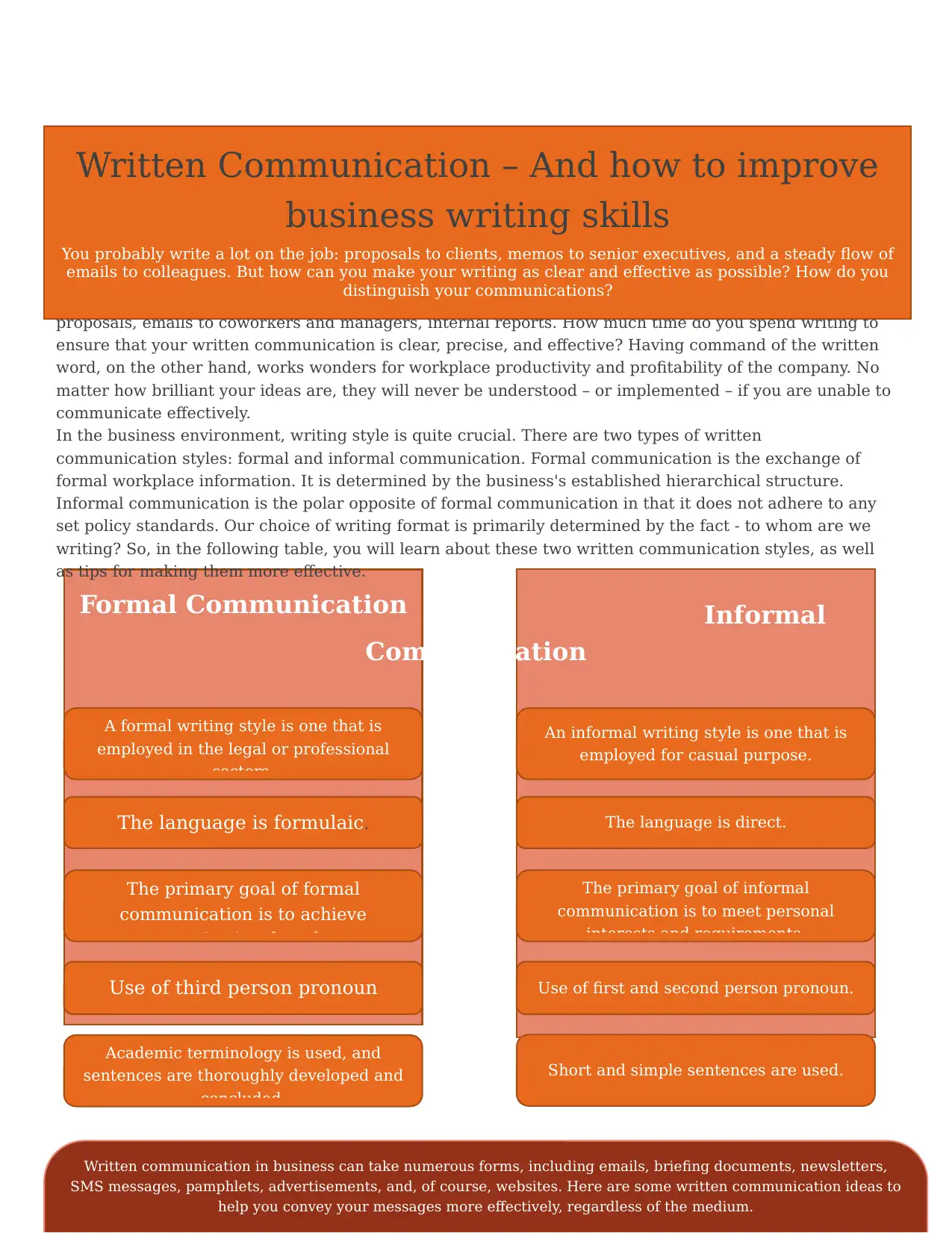
Formal Communication
We aren't all writers, but we all write. At work, you constantly produce written messages — client
proposals, emails to coworkers and managers, internal reports. How much time do you spend writing to
ensure that your written communication is clear, precise, and effective? Having command of the written
word, on the other hand, works wonders for workplace productivity and profitability of the company. No
matter how brilliant your ideas are, they will never be understood – or implemented – if you are unable to
communicate effectively.
In the business environment, writing style is quite crucial. There are two types of written
communication styles: formal and informal communication. Formal communication is the exchange of
formal workplace information. It is determined by the business's established hierarchical structure.
Informal communication is the polar opposite of formal communication in that it does not adhere to any
set policy standards. Our choice of writing format is primarily determined by the fact - to whom are we
writing? So, in the following table, you will learn about these two written communication styles, as well
as tips for making them more effective.
Informal
Communication
Written Communication – And how to improve
business writing skills
You probably write a lot on the job: proposals to clients, memos to senior executives, and a steady flow of
emails to colleagues. But how can you make your writing as clear and effective as possible? How do you
distinguish your communications?
A formal writing style is one that is
employed in the legal or professional
sectors.
Academic terminology is used, and
sentences are thoroughly developed and
concluded.
The primary goal of formal
communication is to achieve
organizational goals.
The language is formulaic.
Use of third person pronoun
An informal writing style is one that is
employed for casual purpose.
The language is direct.
The primary goal of informal
communication is to meet personal
interests and requirements.
Use of first and second person pronoun.
Short and simple sentences are used.
Written communication in business can take numerous forms, including emails, briefing documents, newsletters,
SMS messages, pamphlets, advertisements, and, of course, websites. Here are some written communication ideas to
help you convey your messages more effectively, regardless of the medium.
We aren't all writers, but we all write. At work, you constantly produce written messages — client
proposals, emails to coworkers and managers, internal reports. How much time do you spend writing to
ensure that your written communication is clear, precise, and effective? Having command of the written
word, on the other hand, works wonders for workplace productivity and profitability of the company. No
matter how brilliant your ideas are, they will never be understood – or implemented – if you are unable to
communicate effectively.
In the business environment, writing style is quite crucial. There are two types of written
communication styles: formal and informal communication. Formal communication is the exchange of
formal workplace information. It is determined by the business's established hierarchical structure.
Informal communication is the polar opposite of formal communication in that it does not adhere to any
set policy standards. Our choice of writing format is primarily determined by the fact - to whom are we
writing? So, in the following table, you will learn about these two written communication styles, as well
as tips for making them more effective.
Informal
Communication
Written Communication – And how to improve
business writing skills
You probably write a lot on the job: proposals to clients, memos to senior executives, and a steady flow of
emails to colleagues. But how can you make your writing as clear and effective as possible? How do you
distinguish your communications?
A formal writing style is one that is
employed in the legal or professional
sectors.
Academic terminology is used, and
sentences are thoroughly developed and
concluded.
The primary goal of formal
communication is to achieve
organizational goals.
The language is formulaic.
Use of third person pronoun
An informal writing style is one that is
employed for casual purpose.
The language is direct.
The primary goal of informal
communication is to meet personal
interests and requirements.
Use of first and second person pronoun.
Short and simple sentences are used.
Written communication in business can take numerous forms, including emails, briefing documents, newsletters,
SMS messages, pamphlets, advertisements, and, of course, websites. Here are some written communication ideas to
help you convey your messages more effectively, regardless of the medium.
Paraphrase This Document
Need a fresh take? Get an instant paraphrase of this document with our AI Paraphraser
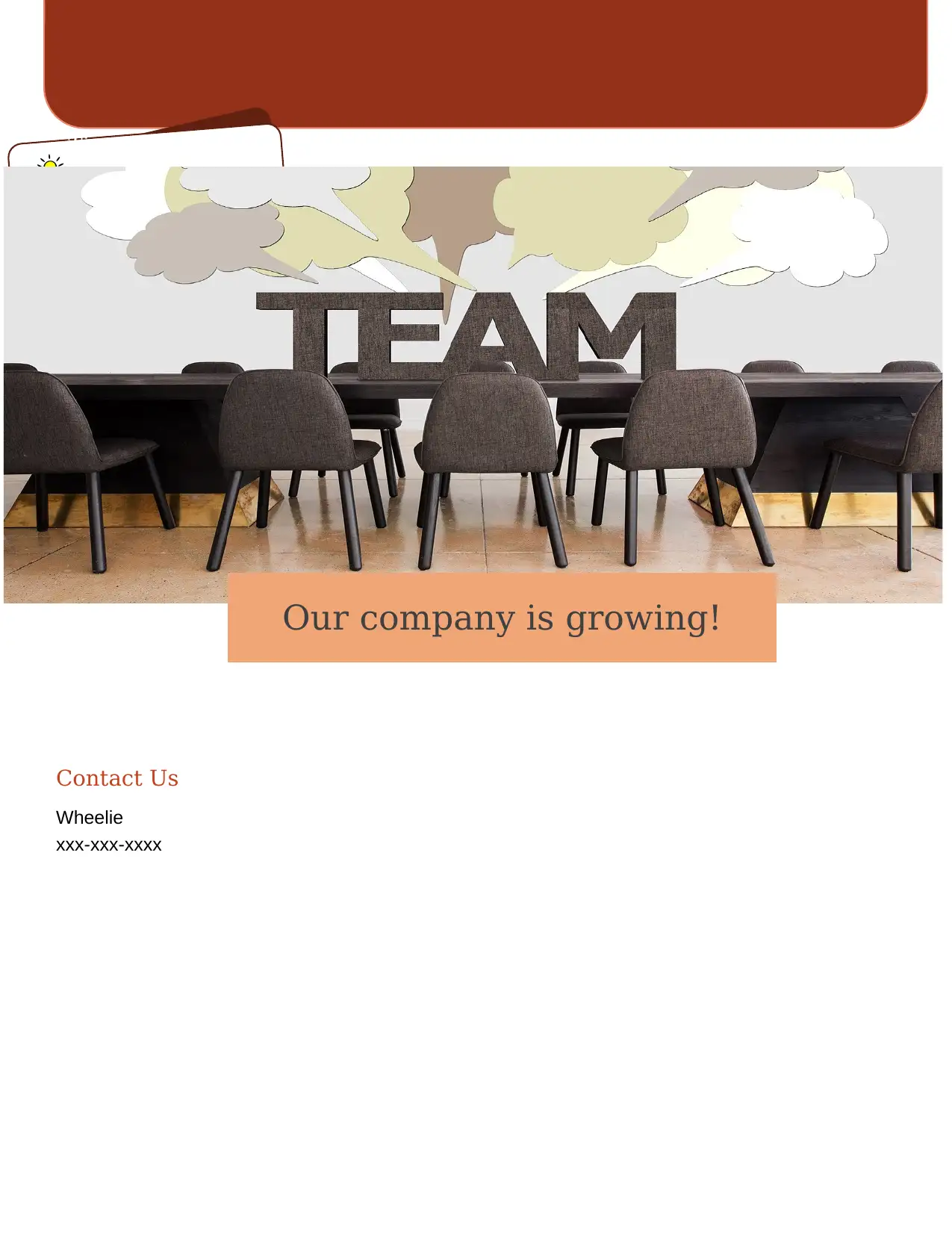
Contact Us
Wheelie
xxx-xxx-xxxx
Tips to improve
written
communication!
Our company is growing!
Wheelie
xxx-xxx-xxxx
Tips to improve
written
communication!
Our company is growing!
1 out of 5
Related Documents
Your All-in-One AI-Powered Toolkit for Academic Success.
+13062052269
info@desklib.com
Available 24*7 on WhatsApp / Email
![[object Object]](/_next/static/media/star-bottom.7253800d.svg)
Unlock your academic potential
Copyright © 2020–2025 A2Z Services. All Rights Reserved. Developed and managed by ZUCOL.



